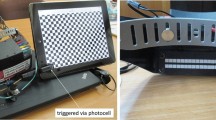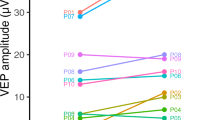Abstract
Purpose: In the difficult-to-test paediatric population, shorter test procedures are desirable. This study investigates whether Laplacian analysis of a three occipital-electrode montage detects steady-state VEPs (ssVEPs) more often or faster in children than a conventional montage, and if so, in which age groups. Methods: Steady-state VEPs (7.78 reversals/s; checkerboard stimulus) to various checksizes (60–3', 0.07–14 cpd equivalent) were recorded from 80 normal children aged from 1 month to 13 years and 19 adults. Active occipital electrodes were placed at Oz and symmetrically either side at 15% of the subject's half-head circumference (right occipital and left occipital, RO and LO). The Laplacian analysis used 2Oz-(RO+LO) instead of the conventional Oz-Fz. Fourier analysis and a circular T 2 statistic was used to determine VEP detection time (DT). The number of responses detected overall by each analysis method and the effects of age and checksize on DT differences between analysis methods were investigated. Results: The Laplacian analysis detected more VEPs than the conventional Oz-Fz (95 versus 84%, p=0.001) in children's age groups. The Laplacian analysis also provided faster response detection to 3' checks in all subjects over the age of five, and to 6' and 9' in 7–9-year-olds. Conclusion: A Laplacian analysis offers increased sensitivity and faster VEP detection over conventional (Oz-Fz) recording in children over five for threshold-sized VEPs. Simultaneous use of both conventional (Oz-Fz) VEP recording and a Laplacian analysis in all patient ages is likely to give faster, more accurate VEP assessments.
Similar content being viewed by others
References
Regan D. Some characteristics of average steady-state and transient responses evoked by modulated light. Electroencephalogr Clin Neurophysiol 1966; 20, 238–48.
Blumhardt LD, Barrett G, Halliday A. The asymmetrical visual evoked potential to pattern reversal in one half field and its significance forthe analysis of visual field defects. BrJ Ophthalmol 1977; 61: 454–61.
Maier J, Dagnelie G, Spekreijse H, Van Dijk B.W. Principal components analysis forsour ce localisation of VEPs in man. Vision Res 1987; 27: 165–77.
Jasper HH. The ten twenty electrode system of the international federation. Electroencephalogr Clin Neurophysiol 1958; 10: 371–5.
Harding GFA, Odom JV, Spileers W, Spekreijse H. Standard forvisual voked potentials1995. Vision Res 1986; 36: 3567–72.
Nunez PL. EEG Recording, electrode placement, and aspects of generator localisation. In: Nunez PL, ed. Electric Fields of the Brain. New York: Oxford University Press, 1981.
Flanagan JG, Harding GF. Source derivation of the visually evoked potential. Doc Ophthalmol 1986; 62: 97–105.
Clement RA, Flanagan JG, Harding GF. Source derivation of the visual evoked response to pattern reversal stimulation. Electroencephalogr Clin Neurophysiol 1985; 62: 74–6.
Manahilov V, Riemslag FC, Spekreijse H. The Laplacian analysis of the pattern onset response in man. Electroencephalogr Clin Neurophysiol 1992; 82: 220–4.
Beers APA, Riemslag FC, Spekreijse H. Visual evoked potential estimation of acuity with a Laplacian derivation. Doc Ophthalmol 1992; 79: 383–9.
Apkarian P, Bour LJ. Laplacian analysis facilitates VEP pattern onset acuity estimates: concomitant Snellen acuity equivalents in paediatric patients [abstract]. ISCEV Annual Symposium Programme. 2000.
Mackay AM, Bradnam MS, Hamilton R. A Laplacian analysis provides faster detection times than conventional recording forsteady-state visual evoked potentials (ssVEPs) [abstract] Invest Ophthalmol Vis Sci Suppl 2001; 42: 4237.
Mackay AM, Bradnam MS, Hamilton R. Faster threshold VEP recording. Clin Neurophysiol 2003. accepted for publication.
Bradnam MS, Evans ALM, Montgomery D, Keating D, Damato BE, Cluckie A, Allan D. A personal computer-based visual evoked potential stimulus and recording system. Doc Ophthalmol 1994; 86: 81–93.
Victor JD, Mast J. A new statistic forsteady-state evoked potentials. Electroencephalogr Clin Neurophysiol 1991; 78: 378–88.
Hendrickson A, Youdelis C. The morphological development of the human fovea. Ophthalmology 1984; 91: 603–12.
Yuodelis C, Hendrickson A. A qualitative and quantitative analysis of the human fovea during development. Vision Res 1986; 26: 847–55.
Candy TR, Crowell JA, Banks MS. Optical, receptoral and retinal contraints on foveal and peripheral vision in the human neonate. Vision Res 1998; 38: 3857–70.
Huttenlocher PR, de Courten C, Garey LJ, Van der Loos H. Synaptogenesis in human visual cortex - evidence for synapse elimination during normal development. Neurosci Lett 1982; 33: 247–52.
Garey LJ. Structural development of the visual system of man. Hum Neurobiol 194; 3: 75–80.
Norcia AM, Tyler CW. Spatial-frequency sweep VEP-visual acuity during the first year of life. Vision Res 1985; 25: 1399–408.
Srinivasan R. Spatial structure of the human alpha rhythm: global correlation in adults and local correlation in children. Clin Neurophysiol 1999; 110: 1351–62.
Sokol S. Measurement of infant visual acuity from pattern reversal evoked potentials. Vision Res 1978; 18: 33–9.
Skoczenski AM, Norcia AM. Development of VEP vernier acuity and grating acuity in human infants. Invest Ophthalmol Vis Sci 1999; 40(10): 2411–17.
Allen D, Tyler CW, Norcia AM. Development of grating acuity and contrast sensitivity in the central and peripheral visual field of the human infant. Vision Res 1996; 36(13): 1945–53.
Author information
Authors and Affiliations
Rights and permissions
About this article
Cite this article
Mackay, A.M., Hamilton, R. & Bradnam, M.S. Faster and more sensitive VEP recording in children. Doc Ophthalmol 107, 251–259 (2003). https://doi.org/10.1023/B:DOOP.0000005334.70304.c7
Issue Date:
DOI: https://doi.org/10.1023/B:DOOP.0000005334.70304.c7




